Kinkakuji (Golden Pavilion) and Ginkakuji (Silver Pavilion) Kyoto Shrines
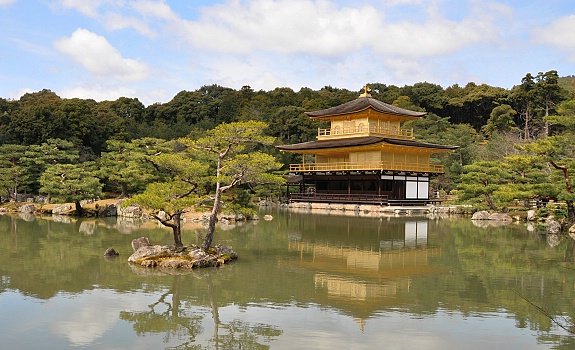
Kinkakuji (金閣寺, Golden Pavilion) is a Zen temple in northern Kyoto whose top two floors are completely covered in gold leaf. Formally known as Rokuonji, the temple was the retirement villa of the shogun Ashikaga Yoshimitsu, and according to his will it became a Zen temple of the Rinzai sect after his death in 1408. Kinkakuji was the inspiration for the similarly named Ginkakuji (Silver Pavilion), built by Yoshimitsu's grandson, Ashikaga Yoshimasa, on the other side of the city a few decades later.
Kinkakuji is an impressive structure built overlooking a large pond, and is the only building left of Yoshimitsu's former retirement complex. It has burned down numerous times throughout its history including twice during the Onin War, a civil war that destroyed much of Kyoto; and once again more recently in 1950 when it was set on fire by a fanatic monk. The present structure was rebuilt in 1955.
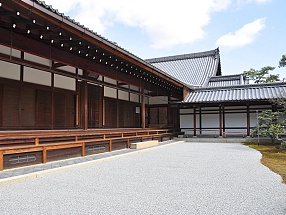
The head priest's former living quarters (hojo)
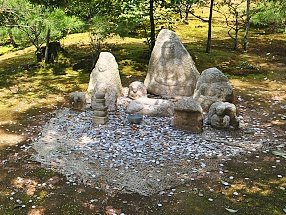
Coin Toss
After viewing Kinkakuji from across the pond, visitors pass by the head priest's former living quarters (hojo) which are known for their painted sliding doors (fusuma), but are not open to the public. The path once again passes by Kinkakuji from behind then leads through the temple's gardens which have retained their original design from Yoshimitsu's days. The gardens hold a few other spots of interest including Anmintaku Pond that is said to never dry up, and statues that people throw coins at for luck.
Continuing through the garden takes you to the Sekkatei Teahouse, added to Kinkakuji during the Edo Period, before you exit the paid temple area. Outside the exit are souvenir shops, a small tea garden where you can have matcha tea and sweets (500 yen) and Fudo Hall, a small temple hall which houses a statue of Fudo Myoo, one of the Five Wisdom Kings and protector of Buddhism. The statue is said to be carved by Kobo Daishi, one of the most important figures in Japanese religious history.
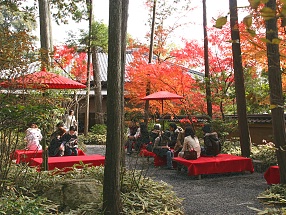
Tea Garden
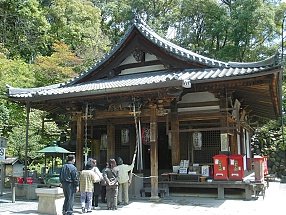
Fudo Hall
Access
Kinkakuji can be accessed from Kyoto Station by direct Kyoto City Bus number 101 or 205 in about 40 minutes and for 230 yen. Alternatively, it can be faster and more reliable to take the Karasuma Subway Line to Kitaoji Station (15 minutes, 260 yen) and take a taxi (10 minutes, 1000-1200 yen) or bus (10 minutes, 230 yen, bus numbers 101, 102, 204 or 205) from there to Kinkakuji.
How to get to and around Kyoto
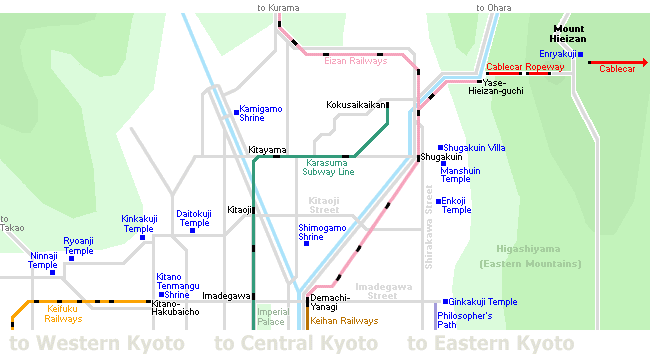
Hours & Fees
Hours
9:00 to 17:00
Closed
No closing days
Admission
400 yen
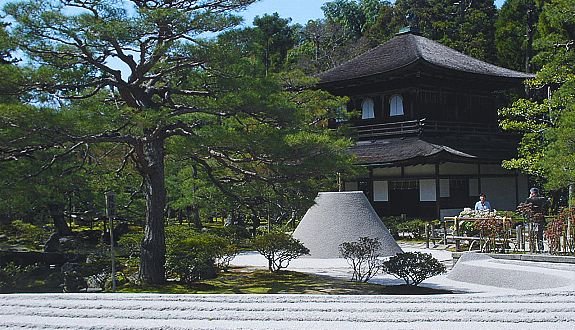
Ginkakuji (銀閣寺, Silver Pavilion) is a Zen temple along Kyoto's eastern mountains (Higashiyama). In 1482, shogun Ashikaga Yoshimasa built his retirement villa on the grounds of today's temple, modeling it after Kinkakuji (Golden Pavilion), his grandfather's retirement villa at the base of Kyoto's northern mountains (Kitayama). The villa was converted into a Zen temple after Yoshimasa's death in 1490.
As the retirement villa of an art obsessed shogun, Ginkakuji became a center of contemporary culture, known as the Higashiyama Culture in contrast to the Kitayama Culture of his grandfather's times. Unlike the Kitayama Culture, which remained limited to the aristocratic circles of Kyoto, the Higashiyama Culture had a broad impact on the entire country. The arts developed and refined during the time include the tea ceremony, flower arrangement, noh theater, poetry, garden design and architecture.
Today, Ginkakuji consists of the Silver Pavilion, half a dozen other temple buildings, a beautiful moss garden and a unique dry sand garden. It is enjoyed by walking along a circular route around its grounds, from which the gardens and buildings can be viewed.
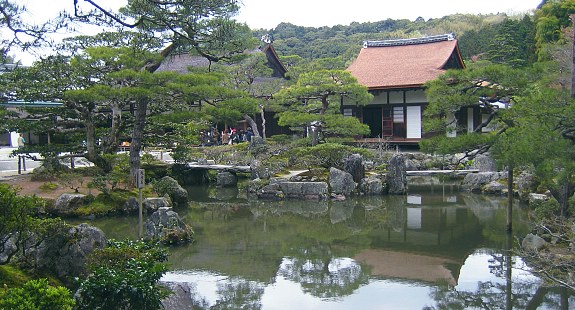
The Hondo (left behind the tree) and Togudo Hall (right)
A first sight of the Silver Pavilion can be enjoyed shorty after entering the grounds. Formally named Kannonden (Kannon Hall), the pavilion's two stories are constructed in two different architecture styles and contain a statue of Kannon, the Buddhist goddess of mercy. However, the interior of the building is not open to the public.
Despite its name, the Silver Pavilion was never covered in silver. Instead, it is believed that the name arose as a nickname more than a century after the building's construction to contrast it with the Golden Pavilion. Alternatively, it is explained that moon light reflecting on the building's dark exterior (which used to be covered in black lacquer in the past) gave it a silvery appearance.
The pavilion is one of only two buildings on the grounds of Ginkakuji which have survived intact the many fires and earthquakes of the past centuries, although it has been undergoing periodical renovation works to keep it well preserved. Most recently the building's roof was redone and its earthquake resistance was improved. The works were completed in spring 2010.
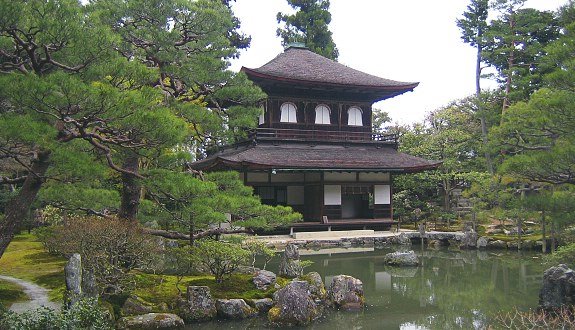
Silver Pavilion
Next along the route is an expansive, meticulously maintained dry sand garden, known as the "Sea of Silver Sand", with a massive sand cone named "Moon Viewing Platform". Besides the garden stands the Hondo (main hall), which displays paintings on its sliding doors (fusuma) but cannot be entered.
Right next to the Hondo stands the Togudo, Ginkakuji's only other temple building besides the Silver Pavilion which dates back to the temple's foundation. The Togudo is celebrated for containing a study room of 4.5 tatami mats, which is considered to be the oldest extant example of Shoin architecture, the architecture style in which most contemporary tatami rooms are still designed today. The building and its study room are not usually open to the public.
After passing by the Togudo, the walking path then takes visitors through Ginkakuji's moss garden, which features ponds with islands and bridges, little streams and various plants. The path climbs a hill behind the buildings from where there are nice views of the entire temple grounds and the city beyond. At last, visitors can enjoy once more some closer views of the Silver Pavilion before exiting the grounds
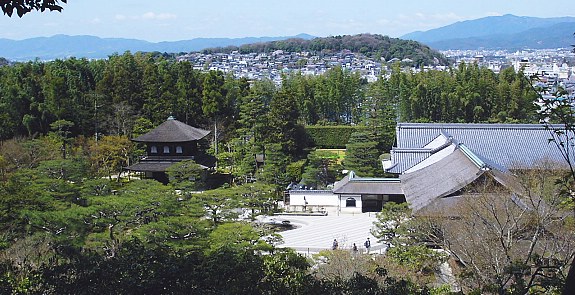
View from the hill behind the buildings
Access
Ginkakuji can be accessed by direct bus number 5, 17 or 100 from Kyoto Station in about 35-40 minutes and for 230 yen one way. Alternatively, you can reach Ginkakuji by foot along the Philosopher's Path from Nanzenji in about 30-45 minutes.
How to get to and around Kyoto
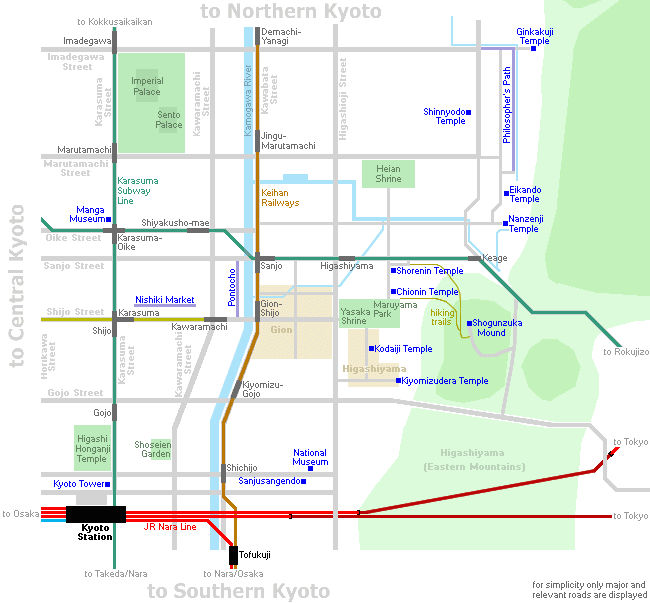
Hours & Fees
Hours
8:30 to 17:00 (9:00 to 16:30 from December to February)
Closed
No closing days
Admission
500 yen